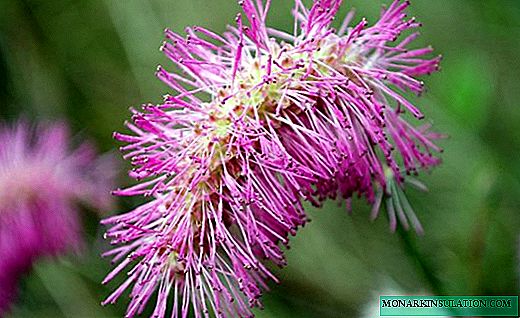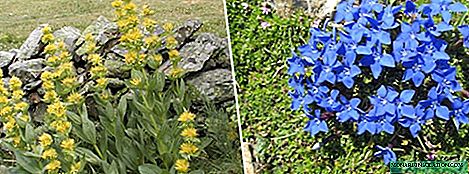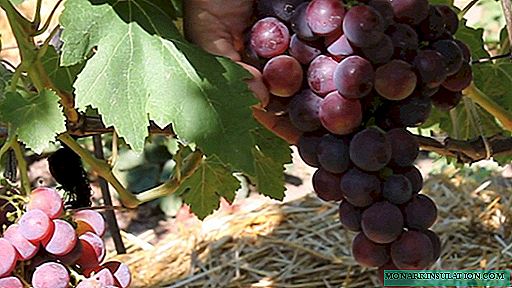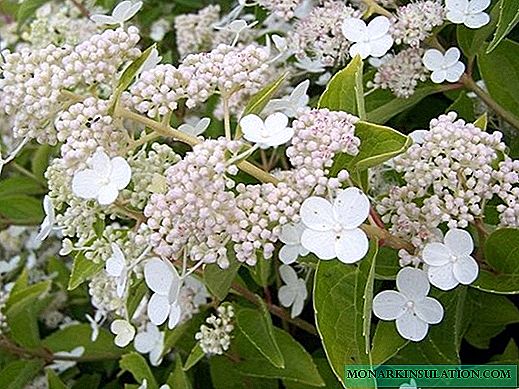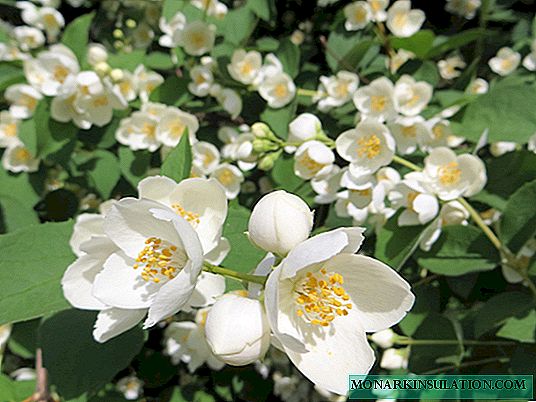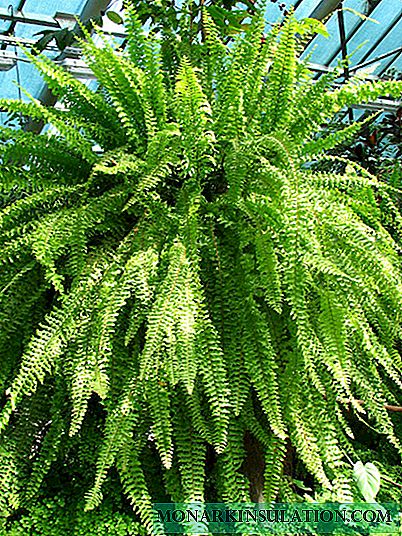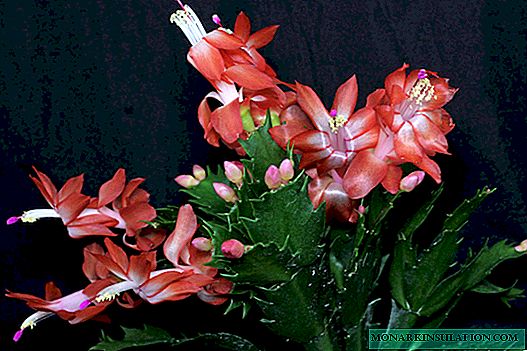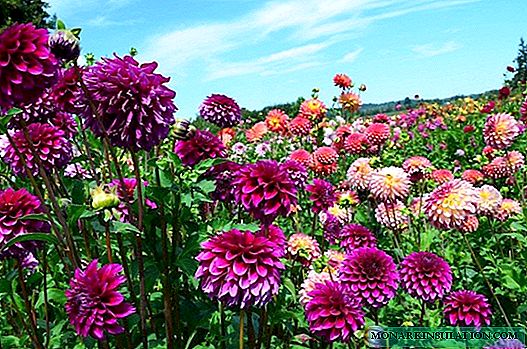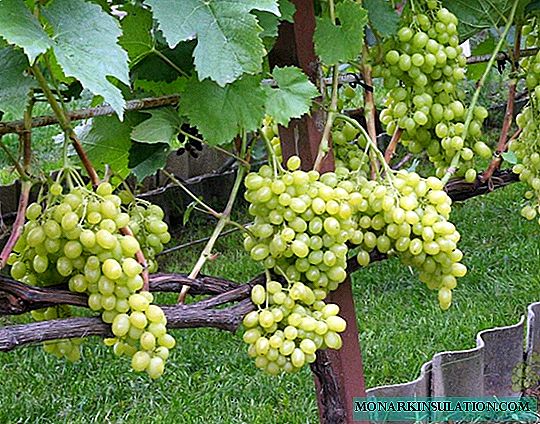
Grapes - this is one of the first plants that people began to cultivate long before the advent of our era. Nowadays, about 600 species of this sun berry are distributed throughout the globe. More than 8 thousand different grape varieties were bred by breeders, one of them is Tukay.
The story of the Tukay grape
On the Don land, in the city of Novocherkassk there is an All-Russian Research Institute of Viticulture and Winemaking named after Ya. I. Potapenko, who began his history back in the 30s of the twentieth century with the first scientific experiments of academician N. I. Vavilov. It is at this institute that breeders are constantly working on the creation of new grape varieties that would be resistant to disease and not afraid of frost, but at the same time bring a rich and tasty harvest. As a result of crossing the Central Asian variety Yakdona (synonyms of Yakdon white, Egdona Turkmen, Ak yakdona) and the old Hungarian variety Zhemchug Saba, a new high-quality hybrid Tukai was obtained. It belongs to the category of Euro-Asian varieties.
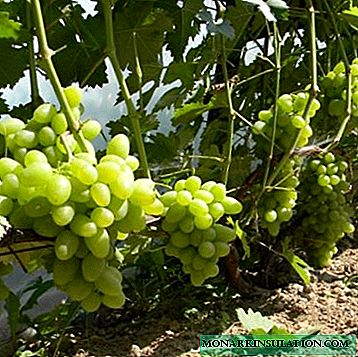
The Tukai grape variety was bred at the All-Russian Research Institute of Viticulture and Winemaking named after Y. I. Potapenko
Description of Tukay variety
From "parents" Tukay took the best qualities: a short ripening period of the Yakdon variety and frost resistance of the Zhemchug Saba variety. The bushes of this grape are vigorous, the maximum number of berries ripens on one vine. Seedlings quickly and well take root. The flowers of Tukai are bisexual, so the pollination process takes place without problems (it can be violated only if rains pour continuously during the flowering of the grapes, but this is only possible theoretically). Leaves of medium size, light green, slightly dissected.

Tukay berries weigh 2-4 g, and from one bush you can harvest up to 20 kg
The clusters are large, branched, cylindrical-conical. The density of the hands is medium. The weight of the brush, on average, is 700-800 grams, but can reach a kilogram! The berries are round, oval, weighing 2-4 grams, as a rule, do not crumble. The color of the berries, depending on the sunlight, can vary from light green and milky white to amber, with a slight “tan”. The pulp is juicy, sweet, with acidity and nutmeg aroma. Sugar content of 17-19%. The skin is dense, but not stiff. Tukai is a high-yielding variety. With proper care and proper pruning from one bush, you can remove 16-20 kilograms of berries.
Plant characteristics
The Tukay grape variety belongs to high-quality table hybrids of early ripening. The growing season in the southern regions of our country is 90-100 days. But it is also successfully grown in the middle lane, in the Urals, and in the forest-steppe zones of Siberia, in particular, in the Altai Territory. There the vine will ripen a little longer, about 130 days. Frost resistance of this variety allows not to cover the lashes for the winter in the southern areas of growth, since the kidneys withstand a drop in air temperature to -25 ° C. In regions with more severe frosts, grapes should still be prepared for winter. For this, you can use ordinary materials: plastic film, roofing felt, fabric, spruce spruce branches, cardboard, etc.

Despite the fact that Tukay can withstand frosts of -25 ° C, in the northern regions it should be covered with a film for the winter
Early ripening allows you to get the crop in August, and in the southern regions even at the end of July. Moreover, if it is not possible to harvest immediately after ripening, you can do it later. Berries can be stored for a long time on the bush without crumbling and without losing their taste and appearance. Tukai has good transportability, it is not damaged when transported over long distances. It is also stored very well until spring, unless, of course, favorable storage conditions are created. Store grapes in a dry room with a temperature of 1-8 ° C.
Despite the fact that Tukay grows well and bears fruit in regions with a cold climate, he prefers the climate is warm, but not very hot. If the air warms above 35 ° C, the growth and fruiting of the bush may slow down.
Features of planting and growing
No matter how high-quality characteristics a hybrid grape variety possesses, it is impossible to get a good harvest without following all agrotechnical measures. It is necessary to work hard and provide proper care to the plant throughout the season.
Landing
Like any grape, Tukai prefers to grow in well-lit, draft protected areas. Ideal to plant it along the south side of a building or fence. The composition of the soil, this variety is not very demanding. If there is no chernozem, loamy and loamy soils will do. Salt marshes and excessively damp, wetlands are not suitable for him. The roots of the grapes go to great depths, so the close occurrence of groundwater will quickly destroy the plant.

At the bottom of the pit for planting grapes should be laid drainage
Cuttings are pre-soaked in water for several days to accelerate the formation of roots. When planting, cuttings should be buried in well-fertilized trenches or pits by about 50 cm. This will contribute to the development of the root system, facilitate the sheltering of bushes for the winter, and the snow retention procedure, which is very important to prevent freezing of grapes. Drainage of gravel, dry branches and sticks is laid at the bottom of the trench, then it is covered with earth mixed with sand and organic and complex mineral fertilizers. Planted cuttings must be abundantly watered and mulched.
Pruning
Since the bushes of the Tukay variety are widely growing, and a lot of clusters are tied, it is necessary to ensure that the shoots are not heavily overloaded. Otherwise, the berries will grow small and unsweetened. In the spring, at the beginning of the growing season, weak shoots are removed, and the extra buds are pinched. It is necessary to leave 40-45 fruiting buds on the bush, and on the shoot - 6-7 eyes. Remote shoots can be used for propagation by green cuttings. Left shoots are tied to trellises.

In colder regions, grape pruning is best done in the fall after harvest.
If the threat of spring frosts remains, you need to leave covering materials on the bushes for a while. In regions with a cold climate, it is sometimes difficult to cut the shoots in the spring because of the danger to please the period of the beginning of sap flow. Therefore, pruning there is best done in the fall, after harvesting and falling leaves, when the root system is preparing for wintering. It should be noted that the larger the grapes, the fewer eyes should be left on the bush.
Watering
Watering should be done several times a season, correctly considering the weather conditions. Spring and autumn irrigation is called moisture recharge. Their goal is to saturate the earth as deep as possible, because the roots of the grapes go very deep. However, if after a snowy winter the soil is already sufficiently moistened, you should not water it much. Autumn watering in anticipation of frosts should be quite plentiful, since dry soil freezes much faster than wet.
Water temperature is selected depending on the purpose. During spring planting, irrigation with hot water will warm the earth and stimulate the growth and development of the vine. But with the threat of late frosts, it is better to pour cool water to delay the budding of the kidneys.

During spring irrigation of grapes, water should penetrate the soil as deep as possible
In summer, you need to water 1-2 times a week, focusing on air temperature, always in the evening, at sunset. One plant should account for 5 to 20 liters of water. These recommendations are conditional, because in different climatic regions there should be an individual approach to irrigation. The main goal is to prevent both overdrying and waterlogging of the soil, since grapes are very sensitive to such nuances.
Top dressing
If complex fertilizers were applied during planting, then during the summer growing season you can not feed and not spray plants. Weeding and loosening can be reduced to a minimum. Such severe hardening methods are recommended by Rostislav Fedorovich Sharov, a well-known gardener and viticulturist practicing grape cultivation in Biysk. For the Siberian climate, these recommendations seem reasonable. Severe winter frosts will not leave pests a chance to survive, and you can not be afraid that the vine bushes will be affected. But in the southern regions, where frost may not occur at all in winter, the risk of infection with fungal diseases is high.
Grape diseases
Tukay's disease resistance is low. It is not damaged by gray rot, but can suffer from troubles such as oidium and mildew.
Gray rot is a fungal disease caused by the pathogen Botrytis cinerea Pers, whose mycelium hibernates on previously damaged shoots, as well as on fallen leaves and berries. From the beginning of spring to the end of summer, fungal spores actively propagate and are carried by the wind, damaging leaves, shoots, inflorescences and clusters that have already formed. At first, brown spots with a gray coating appear on the leaves and shoots, then the leaves dry up and fall off, and the shoots die off. Inflorescences and berries, when damaged by gray rot, wither and fall off.
Oidium (as well as powdery mildew or ashtray) is a disease caused by fungi of the genus Uncinula of the Ascomycete division. It can live on all vegetative parts of the vine bush, sucking juice from living cells. As a result of damage by oidium, the leaves of shoots and berries become covered with a gray powdery coating, dry up and fall off.
Mildew (downy mildew) is the most dangerous grape disease. It is caused by the fungus Peronospora Viticola de Bary, brought to our hemisphere from North America. The development of mildew is usually promoted by too humid warm weather. Light yellow, oily-transparent spots of rounded shape appear on the leaves of young foliage and angular, located along the veins, of old leaves. Then, on the underside of the leaves under the spots, a white fluff of the mycelium grows. In exactly the same way, the tops of shoots, antennae, inflorescences, ridges and young grapes can be affected. Inflorescences turn yellow, curl, become brown and dry. And the berries turn blue and wrinkle. If the necessary measures are not taken in time, the bush may die.
Photo Gallery: Grape Disease
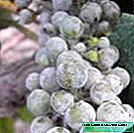
- Oidium-affected berries are covered with a coating, and then fall
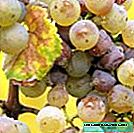
- The first sign of gray rot is the appearance of brown spots with a gray coating

- Mildew develops in too wet and warm weather
How to prevent the defeat of grapes with fungal diseases
- During the spring formation of the bush, make sure that the number of lashes is optimal for good ventilation, and the aisles are wide enough. Thickening of the bush will retain excess moisture, which is so loved by the spores of mildew and oidium.
- Before and after flowering, spraying with 1% Bordeaux liquid or copper (iron) vitriol will protect young ovaries from mildew. You can also use any fungicidal drug offered by the modern chemical industry.
- Treatment with sulfur-containing preparations will protect plants from infection with oidium. It is important that sulfur is in the thinnest form, then dusting it with it will cover all the green parts of the bush. The air temperature for this procedure should be 18-20 ° C, since in cold weather, sulfur will not affect the mycelium of mushrooms, and in the heat it can cause burns on leaves and berries.
- The first treatment of plants should be carried out in early spring, at the beginning of the growing season. Then repeat them every 10-14 days, until the berries ripen. And if the weather is rainy and the sun is not enough, you need to spray more often, every 7 days.
- Mulching the soil around the bushes with ash and spraying the plants with a concentrated solution of ash extract will also help prevent damage to the grapes by diseases. The ash solution should be infused for three days, diluted with water and add liquid soap for better adhesion.
Video: processing grapes with ash solution
Vaccination and reproduction
Agrotechnical measures, of course, largely depend on the climate in which grapes are grown.
In regions with a cold climate, it is recommended to plant Tukai cuttings with a shield on winter-hardy stocks of the type Northern, Far Eastern 60, Alpha, Baytur. This method recommends the previously mentioned Rostislav Fedorovich Sharov.

A method of grafting grapes with a shield is recommended by the famous winegrower Rostislav Fedorovich Sharov
However, nurseries in any region offer seedlings of Tukay grapes already in grafted form on a phylloxera-resistant rootstock.
Phyloxera (Dactylosphaera vitifoliae) is a grape aphid, a small, up to 1 mm long insect that settles on the roots and underground parts of the vine bush, sucking juice from them. Introduced to Europe from North America in the middle of the last century.
So, each grower can choose any method of planting grapes, as well as independently propagate the variety he likes both by grafting and by cuttings.
Cuttings are a very common and effective method of propagating grapes. The Tukai variety is characterized by a good survival rate of cuttings. This should be done in late spring or early summer, when the extra shoots are removed during the formation of the bush. We select the best of them for cuttings. We use only the lower or middle part of the vine, the upper one is not suitable.
- We put the shoots in the bucket as quickly as possible, spray them, cover with a damp cloth and put them into the basement for the night.
- The next day we cut the shoots into cuttings with two leaves. The bottom leaf is cut off completely, and the top is only half. From the bottom, cut the stalk immediately under the kidney, and at the top 1.5 cm above the kidney.
- Next, dip the cuttings in water and plant them in a box of wet sand to a depth of 3 cm, the distance between the cuttings is 10 cm. Spray with water and cover the box with glass or plastic wrap.
- Each subsequent day, it is necessary to spray the cuttings from the spray gun 4-5 times with warm water (20-25 ° C).
- After about two weeks, roots will appear on the cuttings, then the number of sprayings is reduced to three times a day. When the root system has developed sufficiently, we plant the cuttings in a permanent place according to the 10 by 5 cm pattern.
- Further care of the cuttings is carried out as usual.

Approximately 2 weeks after planting, roots will appear on the cuttings, but before planting in the ground, you need to wait until the root system has developed sufficiently
Gardeners reviews
In my practice, I agree with all the good that was said. The bunch can be from 300 g to 1.5 kg: it depends on the conditions for laying the inflorescences in the previous year, pollination. It is always not very well pollinated in me, peas. When compared with Aleshenkin with the same huge amount of inflorescences, it is pollinated much worse (although Aleshenkin is not a champion). Tukai must be standardized - this year at least 50% of the inflorescences have been removed. It is clear that this variety is for yourself. To my taste it is beautiful to taste: thin muscat, thin skin, very juicy. In my home and immediate surroundings, to my taste is considered the most delicious of the super-early growing with me. Our vine always and completely ripens to the very tip. Weak to mildew is very specific - it requires a minimum of 4 sprays. It begins to ripen in our normal years by mid-August. In August, we completely remove it. By this time, mildew is already very striking young growth. Another spraying is advisable, I usually mint the ends. It can hang on the bush for a long time without loss of taste. But to keep it so long is news for me. Need to try. Thanks! Frost resistance, according to my feelings, it is clearly higher than 21 - I think 25-26 °.The bush is old, did not give the surface shape in time, sticks out when laying 40 cm on the ground. I put a piece of cardboard (the long-term part of the sleeves) on what sticks out, and cover the rest with earth. 15 years winters normally. It is clear that this variety in terms of quality is good for the northern zone of viticulture. For southerners.
Treneva Tatyana Ivanovna//forum.vinograd.info/showthread.php?t=2539
I was pleasantly surprised to taste the berries of Tukai on July 16th. So early, and the taste is already very pleasant. Last year was eaten at the end of July. In fact - the champion of precocity. Tatyana Ivanovna, thanks for the cuttings. Bushes are developing normally, satisfied with taste and early maturity.
Tatyana Andreevna, Kremenchug//forum.vinograd.info/showthread.php?t=2539&page=2
Extra-early ripening, frost resistance, high productivity, survival rate in almost any region of the country, amazing nutmeg taste - Tukay grapes can be safely recommended to anyone who wants to taste these wonderful berries, growing them with their own hands.




